T H E D I S T A N C E S and / or C I T I E S (9)
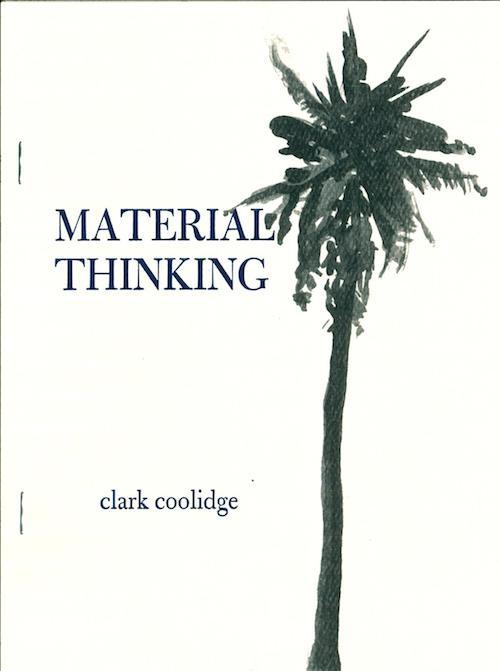
Jason Morris of PUSH (& Big Bell) ushered out this lovely thin pamphlet a few weeks ago. He had come across recordings of two class talks given by poet Clark Coolidge at Naropa in July of 1977. They quite obviously continue and expand upon, even if "just" tangentially, thoughts expressed in his remarks on "Arrangement" originally published in Talking Poetics from Naropa published in 1978. This was the original print source of material from the Jack Kerouac School of Disembodied Poetics set up by Anne Waldman and Allen Ginsberg. For years it was one of the only sources of first hand material available from the poets teaching at Naropa. I personally leaned heavily on my two volume set.
The palm on the cover of Material Thinking is an original watercolor painting by Jason, he's hit a real stride turning out these watercolors of his. The public disclosure of them to his friends came a couple years ago when he reproduced some as fliers for a poetry reading. Here's one of those from off our bathroom wall:
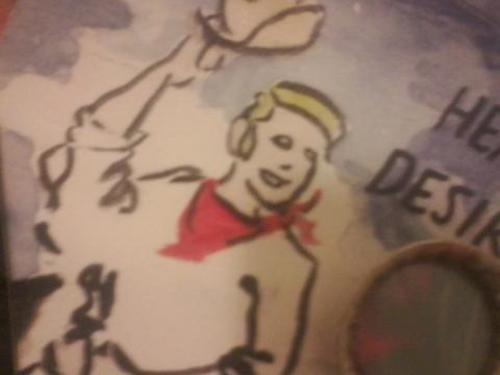
A short while after that, asking him if a pal of ours had ever painted an image of Robert Duncan, I received his own painting of Duncan as a sort of rocknroll Elvis / dreamy Johnny Cash vampire, I dig it:
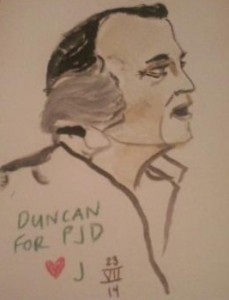
So I'm nothing but excited to see Jason churning out the art for a PUSH title like this with the Coolidge. The covers of Material Thinking were letterpressed by Jason with the help of Nicholas Whittington at "Impart Ink, an errant studio" in an edition of 250 and "privately distributed." Nick edits the exceptional poetry/art fine press rag Amerarcana, along with occasional pamphlet titles, out of his family's bookstore Bird and Beckett Books in the Glen Park neighborhood of San Francisco. Nick also recently assisted Derek Fenner of Bootstrap to letterpress the covers of my partner Ava Koohbor's Triangle Squared: three conversations. Actually, it was a collaborative effort among all three of them as I heard it. They were at the letterpress discussing options for some kind of cover design and Ava reached into the type case drawers and pulled out some wood blocks for over-sized punctuation arranging them just so and bam! there it was:
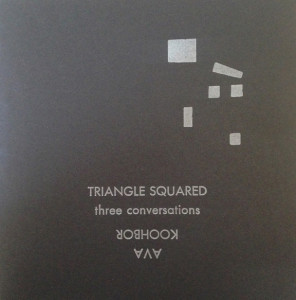
I was impressed with how that cover came out & further stoked all over again when months later Nick showed me the covers for my own pamphlet from Book of Kings (forthcoming Bird and Beckett 2015) which hints towards borrowing a bit of inspiration from Ava's cover.
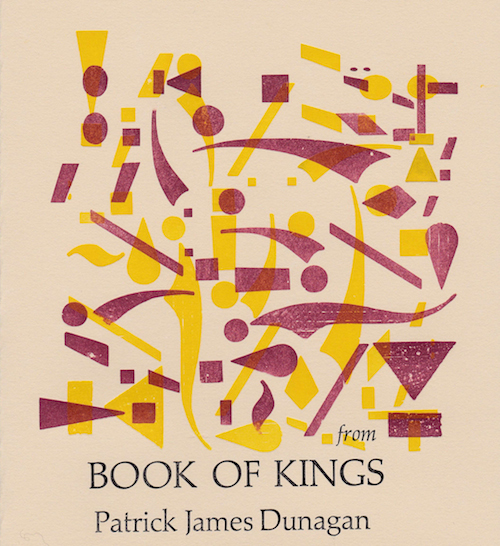
Nick is hitting a seriously on time stride with his letter pressing skill. It is an art, after all, like they say. As was the case with Ava's cover, Jason and Nick came "accidentally" upon an impressive alignment of image and text on the letterpress tray. It's marvelous how the tips of the palm bunch up smooth as ever around the lettering of the title. They didn't plan that shit at all. It was just intuitive sense and a charmed bit of handling the layout.
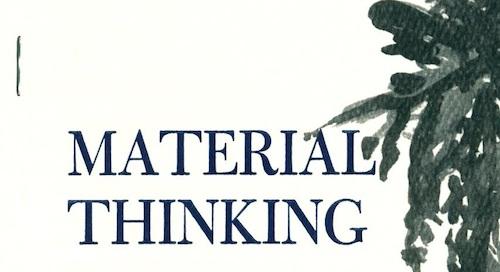
The attention this displays to being-in-the-moment, one with the surrounding materials being used, keeping an eye out not only for potential possibilities of what's working, but following through upon the leads thereby offered, hearkens to mind Coolidge's remarks in his second talk:
Bring it all back down and into the singular. The specific, the one. The unique, as one feels oneself to be in any strong act of focus. From the many the one. And then the next one. Not quite still, but as if just moved or about to move. And the absolutely still? Too impossibly mysterious as every thing seems in motion, if only at the edge. Stillness of that order, perhaps a node particular to mind alone.
This is deep diving into the activity of art/writing/thinking, dwelling with the consciousness afloat in exact wonder. Coolidge, again, "The heavy every, the noted nothing. Olson, Cage." Throughout these two talks Coolidge rattles off a lifetime's worth of reading, looking, talking, pondering (and nearly forty years on he's still at it). After several years familiarity with the painter's work and his own published remarks, along with the numerous commentaries/memoirs which thankfully continue to be published, it's no surprise to me when Coolidge next says, "I find myself very close, in spirit & work, to the 'Yes, But' dialectics of the painter Philip Guston. You never have one thing but you have another, and they are never alike." It's a hesitant wavering. You know what you know but how far does what you know, like know.
In our home we have a large painting of Olson in profile by Ryan Coffey. In Coffey's painting, there's something in the ever constant cigarette in Olson's pawing hand, the dark circles under the staring eyes, and the paused lips that catches elements of the crystalline moment, the bristling pause of heavy wonder, that "strong act of focus" mentioned by Coolidge.
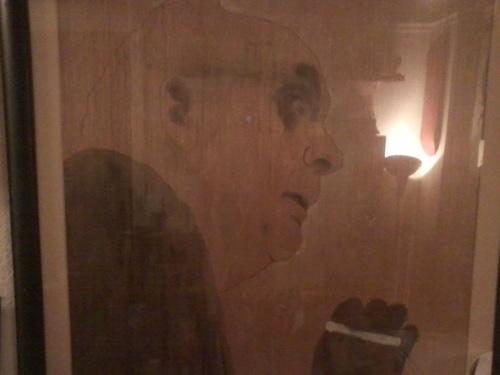
It catches the assertive immersion into the active experience of immediate perception. The sort of solid fact which inserts itself into your whole person. Deeper than any run-of-the-mill "unforgettable memory." This ain't no "I'm going to Disneyland" moment.
Compared to the poem on the page, looking at work by visual artists I've always felt a serious tinge of jealousy for how the work they do is literally taking bits of material that they get to shape and manipulate in such a way as to produce a physical thing that might be viewed, touched, interacted with. It blows my mind how it must feel to look out at a day's work and have an object(s)! looking back at you. As opposed to a sheet(s) of paper with some of my scribbled lines upon them.
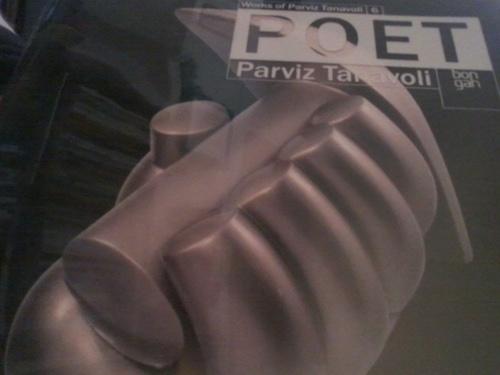
For this reason, the cover alone of Iranian artist Parviz Tanavoli's Poet immediately struck me. I devoured the book and its many images in one sitting on the night it arrived. It came my way as a gift from Ava's mother and father. Her mom's staying with us, on a visit to San Francisco from Tehran. In addition to this book and other gifts, she also cooked up a storm yesterday. The leftovers will feed us all week.
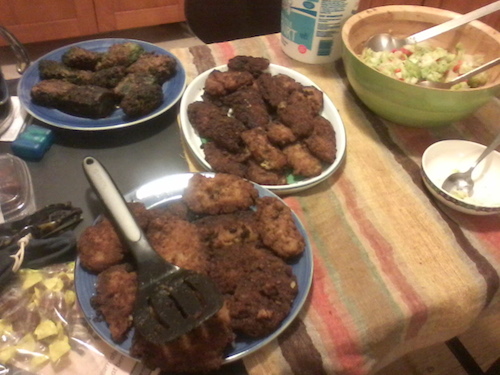
Tanavoli borrows his imagery for "the poet" from the Iranian saga of the mountain carver Farhad, who fell in love with King Khosrow's wife, Shirin. Discovering the brewing romance between the two, Khosrow set Farhad the impossible task of hacking his way through a mountain. Undaunted, Farhad set to work intent on making his way through. In one version of the tale or another, he's tragically misled to believe Shirin has died and in his despair falls to his death from the side of the mountain before completing his task, breaking the heart of Shirin.
There are several series of "poet" sculptures throughout the book, where Tanavoli references the sculptor-as-poet up against "heech" (that is, empty space or "nothingness") i.e. his endless blunt tomb-like sentence of carving into the rock deep through the mountain. I also see it as the poet facing the expansive whiteness of the blank page (or say, Melville's chapter on the color White in Moby Dick).
Also included in the book is a striking work which demonstrates Tanavoli's early development with metalworking technique, and further evidence of his relentless obsession with this tale. His sculpture of Farhad's beloved: Shirin, the Venus of Iran, 196O.
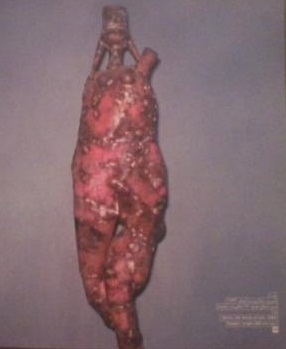
Tanavoli describes the actual materials used in the creation of this piece:
I made a new sculpture by assembling the scraps of copper...mostly in triangular shapes cut from the four corners of circles, circles that were made into pots and pans... and a few pots and pans... For the head of Shirin I used a ewer (aftabeh) by reversing it on the body and added another sprout -- symmetrical to the other -- in order to look like two braids woven on each side of her face.
I love how rough-hewn Tanavoli leaves Shirin's coppery skin. She shimmers in a bluesy way reminiscent of rust belt Americana. Seeing this work in person would certainly freeze me up. I want to crawl inside and rattle her awake. The fact of the matter is that Ava's brother's name is none other than Farhad, and that their last name translates roughly as "mountain cutter." I heard her version of this tale years ago. The difference is that Farhad doesn't fall off the mountain. In her version, agreed upon over the phone by Ava's brother living in Tehran, King Khosrow tricks Shirin herself into driving Farhad's own hammer into his skull.
On the wall in our apartment is Ava's latest work, tentatively titled Golden Alchemy dedicated to her father. A construction composed of wood and no less than 7 different metals, plus patination and not to mention the hand-made chain links swinging from off its bottom.
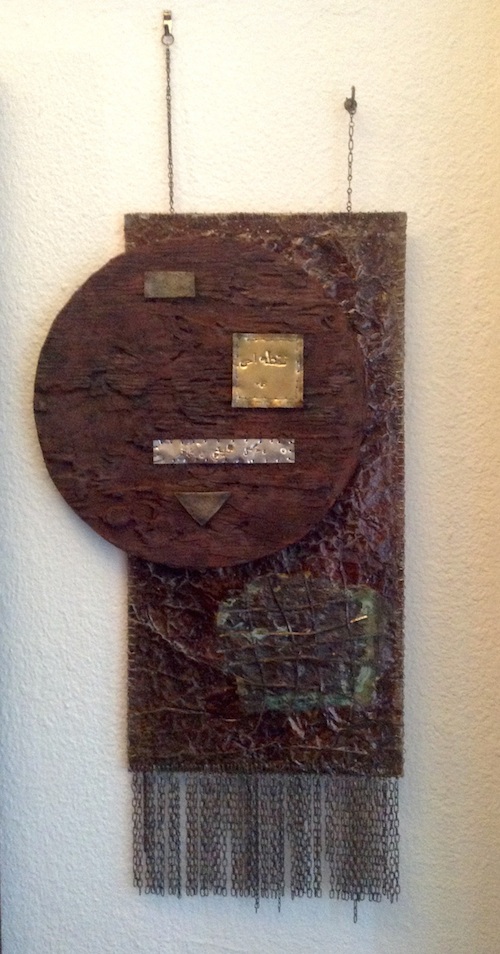
I'm the wood. She's the metal. It's reversed, who cares. Fuck it, we're the dangling chains. It doesn't matter. What matters are the lines of a poem she's engraved upon the work. They're from Parviz Natel Khanlari's poem of the eagle rejecting the crow's life, flying instead into infinity. That dot upon the horizon Corso recognizes as Golden.
Patrick James Dunagan was raised a skateboarder in Southern California and became interested in poetry...
Read Full Biography

